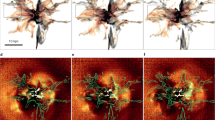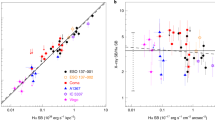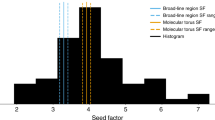Abstract
The hot (107 to 108 kelvin), X-ray-emitting intracluster medium (ICM) is the dominant baryonic constituent of clusters of galaxies. In the cores of many clusters, radiative energy losses from the ICM occur on timescales much shorter than the age of the system1,2,3. Unchecked, this cooling would lead to massive accumulations of cold gas and vigorous star formation4, in contradiction to observations5. Various sources of energy capable of compensating for these cooling losses have been proposed, the most promising being heating by the supermassive black holes in the central galaxies, through inflation of bubbles of relativistic plasma6,7,8,9. Regardless of the original source of energy, the question of how this energy is transferred to the ICM remains open. Here we present a plausible solution to this question based on deep X-ray data and a new data analysis method that enable us to evaluate directly the ICM heating rate from the dissipation of turbulence. We find that turbulent heating is sufficient to offset radiative cooling and indeed appears to balance it locally at each radius—it may therefore be the key element in resolving the gas cooling problem in cluster cores and, more universally, in the atmospheres of X-ray-emitting, gas-rich systems on scales from galaxy clusters to groups and elliptical galaxies.
This is a preview of subscription content, access via your institution
Access options
Subscribe to this journal
Receive 51 print issues and online access
$199.00 per year
only $3.90 per issue
Buy this article
- Purchase on Springer Link
- Instant access to full article PDF
Prices may be subject to local taxes which are calculated during checkout



Similar content being viewed by others
References
Lea, S. M. The dynamics of the intergalactic medium in the vicinity of clusters of galaxies. Astrophys. J. 203, 569–580 (1976)
Cowie, L. L. & Binney, J. Radiative regulation of gas flow within clusters of galaxies: a model for cluster X-ray sources. Astrophys. J. 215, 723–732 (1977)
Fabian, A. C. & Nulsen, P. E. J. Subsonic accretion of cooling gas in clusters of galaxies. Mon. Not. R. Astron. Soc. 180, 479–484 (1977)
Fabian, A. C. Cooling flows in clusters of galaxies. Annu. Rev. Astron. Astrophys. 32, 277–318 (1994)
Peterson, J. R. & Fabian, A. C. X-ray spectroscopy of cooling clusters. Phys. Rep. 427, 1–39 (2006)
Churazov, E., Forman, W., Jones, C. & Böhringer, H. Asymmetric, arc minute scale structures around NGC 1275. Astron. Astrophys. 256, 788–794 (2000)
McNamara, B. R. & Nulsen, P. E. J. Heating hot atmospheres with active galactic nuclei. Annu. Rev. Astron. Astrophys. 45, 117–175 (2007)
Fabian, A. C. Observational evidence of active galactic nuclei feedback. Annu. Rev. Astron. Astrophys. 50, 455–489 (2012)
Bîrzan, L. et al. The duty cycle of radio-mode feedback in complete samples of clusters. Mon. Not. R. Astron. Soc. 427, 3468–3488 (2012)
Churazov, E., Brüggen, M., Kaiser, C. R., Böhringer, H. & Forman, W. Evolution of buoyant bubbles in M87. Astrophys. J. 554, 261–273 (2001)
Omma, H., Binney, J., Bryan, G. & Slyz, A. Heating cooling flows with jets. Mon. Not. R. Astron. Soc. 348, 1105–1119 (2004)
Hillel, S. & Soker, N. Heating cold clumps by jet-inflated bubbles in cooling flow clusters. Preprint at http://arxiv.org/abs/1403.5137
Zhuravleva, I. et al. The relation between gas density and velocity power spectra in galaxy clusters: qualitative treatment and cosmological simulations. Astrophys. J. 788, L13–L18 (2014)
Gaspari, M. et al. The relation between gas density and velocity power spectra in galaxy clusters: high-resolution hydrodynamic simulations and the role of conduction. Astron. Astrophys. 569, A67–A82 (2014)
Fabian, A. C. et al. A very deep Chandra observation of the Perseus cluster: shocks, ripples and conduction. Mon. Not. R. Astron. Soc. 366, 417–428 (2006)
Sternberg, A. & Soker, N. Sound waves excitation by jet-inflated bubbles in clusters of galaxies. Mon. Not. R. Astron. Soc. 395, 228–233 (2009)
Brethouwer, G., Billant, P., Lindborg, E. & Chomaz, J.-M. Scaling analysis and simulation of strongly stratified turbulent flows. J. Fluid Mech. 585, 343–368 (2007)
Arévalo, P., Churazov, E., Zhuravleva, I., Hernández-Monteagudo, C. & Revnivtsev, M. A Mexican hat with holes: calculating low-resolution power spectra from data with gaps. Mon. Not. R. Astron. Soc. 426, 1793–1807 (2012)
Dennis, T. J. & Chandran, B. D. G. Turbulent heating of galaxy-cluster plasmas. Astrophys. J. 622, 205–216 (2005)
Kolmogorov, A. N. The local structure of turbulence in incompressible viscous fluid for very large Reynolds’ numbers. Dokl. Akad. Nauk SSSR 30, 301–305 (1941)
Sreenivasan, K. R. On the universality of the Kolmogorov constant. Phys. Fluids 7, 2778–2784 (1995)
Kaneda, Y., Ishihara, T., Yokokawa, M., Itakura, K. & Uno, A. Energy dissipation rate and energy spectrum in high resolution direct numerical simulations of turbulence in a periodic box. Phys. Fluids 15, L21–L24 (2003)
Beresnyak, A. Spectral slope and Kolmogorov constant of MHD turbulence. Phys. Rev. Lett. 106, 075001 (2011)
Schekochihin, A. A. et al. Astrophysical gyrokinetics: kinetic and fluid turbulent cascades in magnetized weakly collisional plasmas. Astrophys. J. Suppl. Ser. 182, 310–377 (2009)
Churazov, E. et al. X-ray surface brightness and gas density fluctuations in the Coma cluster. Mon. Not. R. Astron. Soc. 421, 1123–1135 (2012)
Sutherland, R. S. & Dopita, M. A. Cooling functions for low-density astrophysical plasmas. Astrophys. J. Suppl. Ser. 88, 253–327 (1993)
Markevitch, M. & Vikhlinin, A. Shocks and cold fronts in galaxy clusters. Phys. Rep. 443, 1–53 (2007)
Subramanian, K., Shukurov, A. & Haugen, N. E. L. Evolving turbulence and magnetic fields in galaxy clusters. Mon. Not. R. Astron. Soc. 366, 1437–1454 (2006)
Balbus, S. A. & Soker, N. Resonant excitation of internal gravity waves in cluster cooling flows. Astrophys. J. 357, 353–366 (1990)
Vikhlinin, A. et al. Chandra temperature profiles for a sample of nearby relaxed galaxy clusters. Astrophys. J. 628, 655–672 (2005)
Churazov, E., Forman, W., Jones, C. & Böhringer, H. XMM-Newton observations of the Perseus Cluster. I. The temperature and surface brightness structure. Astrophys. J. 590, 225–237 (2003)
Foster, A. R., Ji, L., Smith, R. K. & Brickhouse, N. S. Updated atomic data and calculations for X-ray spectroscopy. Astrophys. J. 756, 128–139 (2012)
Smith, R. K., Brickhouse, N. S., Liedahl, D. A. & Raymond, J. C. Collisional plasma models with APEC/APED: emission-line diagnostics of hydrogen-like and helium-like Ions. Astrophys. J. 556, L91–L95 (2001)
Anders, E. & Grevesse, N. Abundances of the elements: meteoritic and solar. Geochim. Cosmochim. Acta 53, 197–214 (1989)
Churazov, E., Sunyaev, R., Forman, W. & Böhringer, H. Cooling flows as a calorimeter of active galactic nucleus mechanical power. Mon. Not. R. Astron. Soc. 332, 729–734 (2002)
McCourt, M., Sharma, P., Quataert, E. & Parrish, I. J. Thermal instability in gravitationally stratified plasmas: implications for multiphase structure in clusters and galaxy haloes. Mon. Not. R. Astron. Soc. 419, 3319–3337 (2012)
Ossenkopf, V., Krips, M. & Stutzki, J. Structure analysis of interstellar clouds. I. Improving the Δ-variance method. Astron. Astrophys. 485, 917–929 (2008)
Sanders, J. S. & Fabian, A. C. Deep Chandra and XMM-Newton X-ray observations of AWM 7 - I. Investigating X-ray surface brightness fluctuations. Mon. Not. R. Astron. Soc. 421, 726–742 (2012)
Ozmidov, R. V. Length scales and dimensionless numbers in a stratified ocean. Oceanology 32, 259–262 (1992)
Braginskii, S. I. Transport processes in a plasma. Rev. Plasma Phys. 1, 205–310 (1965)
Zakamska, N. L. & Narayan, R. Models of galaxy clusters with thermal conduction. Astrophys. J. 582, 162–169 (2003)
Cho, J. et al. Thermal conduction in magnetized turbulent gas. Astrophys. J. 589, L77–L80 (2003)
Norman, M. L. & Bryan, G. L. in The Radio Galaxy Messier 87 (eds Röser, H.-J. & Meisenheimer, K. ) 106–115 (Springer, 1999)
Lufkin, E. A., Balbus, S. A. & Hawley, J. F. Nonlinear evolution of internal gravity waves in cluster cooling flows. Astrophys. J. 446, 529–540 (1995)
Ruszkowski, M. & Oh, S. P. Galaxy motions, turbulence and conduction in clusters of galaxies. Mon. Not. R. Astron. Soc. 414, 1493–1507 (2011)
Randall, S. W. et al. Shocks and cavities from multiple outbursts in the galaxy group NGC 5813: a window to active galactic nucleus feedback. Astrophys. J. 726, 86–104 (2011)
Fujita, Y., Matsumoto, T. & Wada, K. Strong turbulence in the cool cores of galaxy clusters: can tsunamis solve the cooling flow problem? Astrophys. J. 612, L9–L12 (2004)
Banerjee, N. & Sharma, P. Turbulence and cooling in galaxy cluster cores. Mon. Not. R. Astron. Soc. 443, 687–697 (2014)
Kim, W.-T. & Narayan, R. Turbulent mixing in clusters of galaxies. Astrophys. J. 596, L139–L142 (2003)
Chandran, B. D. & Dennis, T. J. Convective stability of galaxy-cluster plasmas. Astrophys. J. 642, 140–151 (2006)
Pfrommer, C. Toward a comprehensive model for feedback by active galactic nuclei: new insights from M87 observations by LOFAR, Fermi, and H.E.S.S. Astrophys. J. 779, 10–28 (2013)
Ciotti, L. & Ostriker, J. P. Cooling flows and quasars. II. Detailed models of feedback-modulated accretion flows. Astrophys. J. 551, 131–152 (2001)
Nulsen, P. E. J. & Fabian, A. C. Fuelling quasars with hot gas. Mon. Not. R. Astron. Soc. 311, 346–356 (2000)
Werner, N. et al. XMM-Newton high-resolution spectroscopy reveals the chemical evolution of M87. Astron. Astrophys. 459, 353–360 (2006)
Acknowledgements
Support for this work was provided by the NASA through Chandra award number AR4-15013X issued by the Chandra X-ray Observatory Center, which is operated by the Smithsonian Astrophysical Observatory for and on behalf of the NASA under contract NAS8-03060. S.W.A. acknowledges support from the US Department of Energy under contract number DE-AC02-76SF00515. I.Z. and N.W. are partially supported from Suzaku grants NNX12AE05G and NNX13AI49G. P.A. acknowledges financial support from Fondecyt 1140304 and European Commission’s Framework Programme 7, through the Marie Curie International Research Staff Exchange Scheme LACEGAL (PIRSES-GA -2010-2692 64). E.C. and R.S. are partially supported by grant no. 14-22-00271 from the Russian Scientific Foundation.
Author information
Authors and Affiliations
Contributions
I.Z.: data analysis, interpretation, manuscript preparation; E.C.: data analysis, interpretation, manuscript preparation; A.A.S.: interpretation, discussions, manuscript preparation; A.C.F.: principal investigator of the Perseus cluster observations, interpretation, manuscript review; S.W.A.: interpretation, discussions, manuscript review; W.R.F.: principal investigator of the M87 observations, interpretation, manuscript review; P.A., J.S.S., A.S., R.S., A.V., N.W.: interpretation, discussions and manuscript review.
Corresponding author
Ethics declarations
Competing interests
The authors declare no competing financial interests.
Extended data figures and tables
Extended Data Figure 1 Thermodynamic properties of the Perseus and Virgo clusters.
Radial profiles of the deprojected electron number density, the electron temperature, the cooling (tcool) and free-fall (tff) times, and the sound speed. Red points: data with 1σ error bars; black curves: data approximations using smooth functions. The increased temperature scatter in the central few kiloparsecs is associated with the presence of multi-temperature plasma in cool cores. A two-temperature fit of high-resolution XMM-Newton RGS spectra of the core of Virgo suggests an ambient temperature there of ∼1.6 keV (ref. 54). The smooth-function approximation we have chosen therefore approaches this value.
Extended Data Figure 2 X-ray image of the core of the Virgo cluster.
a, X-ray surface brightness in units of counts per second per pixel in the 0.5–3.5 keV energy band. b, Relative surface brightness fluctuations. Both images are smoothed with a 3′′ Gaussian. Black circles: excised point sources and central jet. White circles indicate ‘arm-like’ structures associated with the central AGN’s activity, which have also been excised. We adopt 16.9 Mpc as the distance to the cluster, implying that an angular size of 1′ corresponds to a length scale of 4.91 kpc.
Extended Data Figure 3 Set of the radial annuli used in the analysis of the Perseus and Virgo clusters.
The same as Fig. 1b and Extended Data Fig. 1b with white circles indicating the annuli used. The width of each annulus is 1.5′ ≈ 31 kpc in Perseus (a) and 2′ ≈ 9.8 kpc in Virgo (b). The outermost circles are 10.5′ ≈ 218 kpc and 8′ ≈ 39 kpc in Perseus and Virgo, respectively.
Rights and permissions
About this article
Cite this article
Zhuravleva, I., Churazov, E., Schekochihin, A. et al. Turbulent heating in galaxy clusters brightest in X-rays. Nature 515, 85–87 (2014). https://doi.org/10.1038/nature13830
Received:
Accepted:
Published:
Issue Date:
DOI: https://doi.org/10.1038/nature13830
This article is cited by
-
Synchrotron intensity gradient revealing magnetic fields in galaxy clusters
Nature Communications (2024)
-
Mediation of collisionless turbulent dissipation through cyclotron resonance
Nature Astronomy (2024)
-
Cosmic ray feedback in galaxies and galaxy clusters
The Astronomy and Astrophysics Review (2023)
-
A snapshot of the oldest active galactic nuclei feedback phases
Nature Astronomy (2021)
-
Voyage through the hidden physics of the cosmic web
Experimental Astronomy (2021)
Comments
By submitting a comment you agree to abide by our Terms and Community Guidelines. If you find something abusive or that does not comply with our terms or guidelines please flag it as inappropriate.



